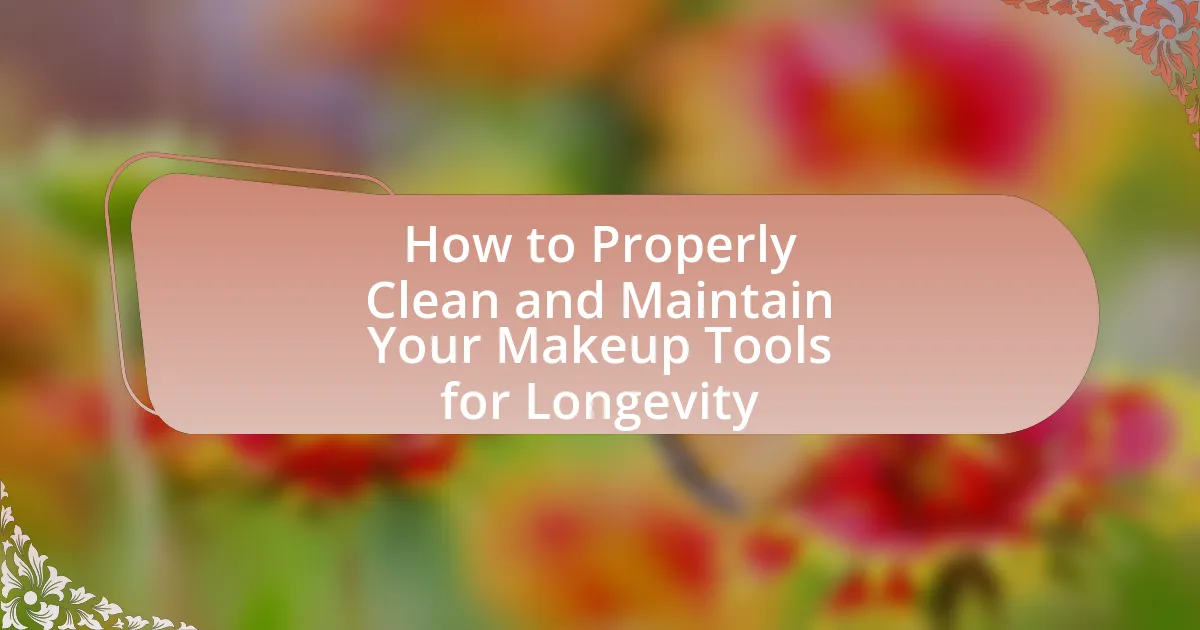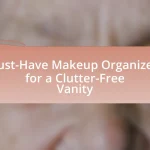The article focuses on the importance of cleaning and maintaining makeup tools to ensure skin health and enhance makeup application. It highlights the risks associated with using dirty tools, such as skin infections and breakouts, and emphasizes the need for regular cleaning to prevent bacteria buildup. The article provides detailed guidance on which tools require cleaning, effective cleaning methods, and maintenance practices that extend the life of makeup tools. Additionally, it discusses the impact of proper storage and common mistakes to avoid, ensuring optimal hygiene and performance of makeup tools.

What is the Importance of Cleaning and Maintaining Makeup Tools?
Cleaning and maintaining makeup tools is crucial for ensuring skin health and optimal makeup application. Regular cleaning prevents the buildup of bacteria, which can lead to skin irritations, breakouts, and infections. Studies indicate that unclean brushes can harbor harmful microorganisms; for instance, a study published in the Journal of Cosmetic Dermatology found that 90% of makeup brushes tested contained bacteria. Additionally, maintaining tools enhances their longevity and performance, as dirty brushes can lead to uneven application and product wastage. Therefore, proper hygiene practices are essential for both personal health and the effectiveness of makeup products.
Why should you clean your makeup tools regularly?
Cleaning your makeup tools regularly is essential to prevent the buildup of bacteria, which can lead to skin infections and breakouts. Studies indicate that dirty brushes can harbor harmful microorganisms; for instance, a study published in the Journal of Cosmetic Dermatology found that 90% of makeup brushes tested contained bacteria. Regular cleaning not only ensures better hygiene but also enhances the performance of the tools, allowing for smoother application and improved makeup results.
What are the risks of using dirty makeup tools?
Using dirty makeup tools poses significant risks, including skin infections, acne breakouts, and allergic reactions. Bacteria, fungi, and other pathogens can thrive on unclean brushes and sponges, leading to conditions such as folliculitis or staph infections. A study published in the Journal of Cosmetic Dermatology found that 90% of makeup brushes harbor harmful bacteria, which can directly contribute to skin issues when applied to the face. Additionally, leftover makeup residue can clog pores, exacerbating acne and irritation. Regular cleaning of makeup tools is essential to mitigate these health risks and maintain skin integrity.
How does cleanliness affect the longevity of makeup tools?
Cleanliness significantly enhances the longevity of makeup tools by preventing the buildup of bacteria, oils, and product residue that can degrade materials over time. Regular cleaning of brushes and sponges not only maintains their performance but also extends their usable life, as studies indicate that unclean tools can lead to bristle damage and deterioration of synthetic fibers. For instance, a study published in the Journal of Cosmetic Science found that brushes cleaned with appropriate methods retained their shape and functionality longer than those that were not maintained, demonstrating that proper hygiene practices directly correlate with the durability of makeup tools.
What types of makeup tools require cleaning?
Makeup tools that require cleaning include brushes, sponges, and applicators. Brushes accumulate makeup residue, oils, and bacteria, making regular cleaning essential to maintain hygiene and performance. Sponges, often used for foundation and concealer, can harbor bacteria if not cleaned frequently, as they absorb moisture and product. Applicators, such as those used for eyeshadow or lip products, also need cleaning to prevent cross-contamination and ensure even application. Regular cleaning of these tools helps prolong their lifespan and promotes skin health by reducing the risk of breakouts and irritation.
Which brushes need special attention during cleaning?
Makeup brushes that need special attention during cleaning include those used for liquid products, such as foundation and concealer brushes, as well as brushes with natural bristles. These brushes require thorough cleaning to prevent product buildup and bacteria growth. Liquid product brushes can trap residue deep within the bristles, making them prone to harboring germs if not cleaned properly. Natural bristle brushes, on the other hand, can be more delicate and may require gentler cleaning methods to maintain their shape and integrity. Regular and careful cleaning of these brushes is essential for both hygiene and the longevity of the tools.
How do you identify when sponges and applicators need cleaning?
Sponges and applicators need cleaning when they show visible signs of product buildup, discoloration, or an unpleasant odor. These indicators suggest that bacteria may be present, which can lead to skin irritation or breakouts. Regular inspection for these signs, ideally after each use or at least weekly, ensures that makeup tools remain hygienic and effective.

How to Properly Clean Your Makeup Tools?
To properly clean your makeup tools, first, use warm water and a gentle soap or brush cleaner to rinse and lather the bristles or surfaces. This method effectively removes makeup residue and bacteria, which can lead to skin irritation or infections. Studies indicate that cleaning tools regularly, ideally once a week, can significantly reduce the risk of breakouts and maintain the integrity of the tools. After rinsing, ensure to reshape the bristles and lay the tools flat to dry, preventing water from seeping into the ferrule, which can weaken the adhesive over time.
What are the best methods for cleaning makeup brushes?
The best methods for cleaning makeup brushes include using gentle soap or brush cleaner, warm water, and a proper rinsing technique. To clean brushes effectively, first, wet the bristles with warm water, then apply a small amount of gentle soap or specialized brush cleaner to the bristles. Gently swirl the brush in the palm of your hand or on a clean surface to work the soap into the bristles, ensuring that the soap reaches the base of the bristles where dirt and bacteria accumulate. Rinse the bristles under warm running water until the water runs clear, avoiding getting water on the ferrule to prevent loosening the glue. Finally, reshape the bristles and lay the brushes flat on a clean towel to dry. Regular cleaning, ideally once a week, helps maintain the brushes’ longevity and prevents skin irritation caused by bacteria buildup.
How do you use soap and water effectively for brush cleaning?
To use soap and water effectively for brush cleaning, first wet the bristles of the brush under lukewarm running water, ensuring that the water does not reach the ferrule to prevent loosening the glue. Next, apply a small amount of gentle soap, such as dish soap or baby shampoo, directly onto the bristles or into the palm of your hand. Gently swirl the brush in the soap, working it into the bristles to break down makeup residue and oils. Rinse the brush thoroughly under running water until the water runs clear, indicating that all soap and residue have been removed. Finally, reshape the bristles and lay the brush flat on a clean towel to dry, preventing water from seeping into the ferrule. This method is effective because it removes dirt and bacteria, promoting hygiene and extending the lifespan of the brushes.
What are the benefits of using specialized brush cleaners?
Specialized brush cleaners effectively remove makeup residue, bacteria, and oils from brushes, ensuring optimal hygiene and performance. These cleaners are formulated to break down cosmetic products, which helps maintain the integrity of brush bristles and prolongs their lifespan. Additionally, using specialized cleaners can enhance the application of makeup, as clean brushes distribute products more evenly and smoothly. Studies indicate that regular cleaning with appropriate products can reduce the risk of skin irritation and breakouts, supporting overall skin health.
How should you clean sponges and other applicators?
To clean sponges and other applicators, immerse them in warm, soapy water and gently squeeze to release makeup and dirt. This method effectively removes residue, as the soap breaks down oils and pigments. After rinsing thoroughly under running water, ensure that all soap is removed to prevent irritation during use. For deeper cleaning, use a brush cleaner or a mixture of equal parts vinegar and water, soaking the applicators for a few minutes before rinsing. Regular cleaning, ideally after each use, helps maintain hygiene and prolongs the lifespan of the tools.
What techniques ensure thorough cleaning of makeup sponges?
Thorough cleaning of makeup sponges can be ensured by using techniques such as soaking in a gentle cleanser, using a brush cleaner, and rinsing thoroughly with warm water. Soaking the sponge in a mixture of warm water and a mild soap or a dedicated sponge cleanser for about 10-15 minutes helps to break down makeup residue. Following this, applying a brush cleaner directly to the sponge and gently massaging it helps to remove stubborn stains and bacteria. Finally, rinsing the sponge under warm running water until the water runs clear ensures that all soap and makeup residues are completely removed. Regular cleaning using these techniques can significantly extend the lifespan of makeup sponges and maintain hygiene.
How often should you replace makeup sponges?
Makeup sponges should be replaced every 3 to 6 months. This timeframe is recommended because over time, sponges can harbor bacteria, become less effective at blending, and deteriorate in quality. Regular replacement ensures optimal hygiene and performance, as studies indicate that makeup tools can accumulate harmful microorganisms if not properly maintained.

What Maintenance Practices Extend the Life of Makeup Tools?
Regular cleaning and proper storage are essential maintenance practices that extend the life of makeup tools. Cleaning brushes and sponges with gentle soap or brush cleaner after each use prevents product buildup and bacteria growth, which can degrade the materials over time. Additionally, storing tools in a dry, clean environment, away from direct sunlight and moisture, helps maintain their integrity and prevents damage. Research indicates that tools maintained in optimal conditions can last significantly longer, with some studies showing a lifespan increase of up to 50% when proper care is taken.
How can proper storage affect the longevity of makeup tools?
Proper storage significantly enhances the longevity of makeup tools by preventing damage and contamination. When makeup brushes and tools are stored in a clean, dry environment, they are less susceptible to mold, bacteria, and wear from environmental factors. For instance, storing brushes upright in a holder prevents bristle deformation, while keeping them away from direct sunlight reduces the risk of material degradation. Research indicates that tools stored in optimal conditions can last up to 50% longer than those improperly stored, highlighting the importance of maintaining a suitable storage environment for makeup tools.
What are the best storage solutions for makeup brushes?
The best storage solutions for makeup brushes include brush holders, organizers with compartments, and magnetic strips. Brush holders, such as cylindrical containers or acrylic organizers, keep brushes upright and prevent bristle damage. Organizers with compartments allow for easy access and separation of different brush types, which helps maintain their shape and hygiene. Magnetic strips can be mounted on walls to store brushes, keeping them visible and accessible while minimizing clutter. These solutions are effective in preserving the quality and longevity of makeup brushes by preventing wear and tear.
How does humidity and temperature impact makeup tool maintenance?
Humidity and temperature significantly affect makeup tool maintenance by influencing the growth of bacteria and the degradation of materials. High humidity levels can create a moist environment that promotes bacterial growth on brushes and sponges, leading to skin irritations and infections. Conversely, extreme temperatures can cause synthetic bristles to warp or degrade, reducing their effectiveness and lifespan. For instance, studies indicate that tools stored in humid conditions require more frequent cleaning to prevent microbial contamination, while those exposed to high heat may need replacement sooner due to material breakdown.
What are common mistakes to avoid when cleaning makeup tools?
Common mistakes to avoid when cleaning makeup tools include using harsh chemicals, neglecting to clean tools regularly, and failing to dry them properly. Harsh chemicals can damage the bristles and materials of brushes, leading to a shorter lifespan. Regular cleaning is essential; studies show that unclean tools can harbor bacteria, which may cause skin issues. Additionally, not drying tools thoroughly can lead to mold growth, compromising their integrity. Proper maintenance ensures longevity and effectiveness of makeup tools.
How can improper cleaning techniques damage your tools?
Improper cleaning techniques can damage your tools by causing corrosion, degradation of materials, and the buildup of harmful bacteria. For instance, using harsh chemicals can erode the bristles of makeup brushes, leading to a loss of functionality and lifespan. Additionally, failing to thoroughly rinse tools can leave residue that attracts dirt and bacteria, which can compromise hygiene and lead to skin issues. Studies have shown that tools not cleaned properly can harbor bacteria, increasing the risk of infections. Therefore, adhering to proper cleaning methods is essential for maintaining the integrity and longevity of makeup tools.
What should you avoid using on your makeup tools?
You should avoid using harsh chemicals on your makeup tools. Harsh chemicals, such as bleach or ammonia, can damage the bristles and materials of brushes and sponges, leading to a decrease in their effectiveness and lifespan. Additionally, these substances can cause skin irritation or allergic reactions when makeup is applied with contaminated tools.
What are some practical tips for maintaining your makeup tools?
To maintain your makeup tools effectively, regularly clean them with a gentle soap or brush cleaner to remove product buildup and bacteria. Cleaning brushes at least once a week prevents skin irritation and ensures optimal application. Additionally, store tools in a clean, dry place to avoid contamination and damage. Using a brush holder or a clean pouch can protect the bristles and maintain their shape. Regularly inspect tools for wear and replace them as needed to ensure they function properly. These practices are essential for hygiene and prolonging the lifespan of your makeup tools.
How can you create a cleaning schedule for your makeup tools?
To create a cleaning schedule for your makeup tools, establish a routine that includes daily, weekly, and monthly cleaning tasks. Daily, clean brushes used for liquid products with a quick-dry brush cleaner to prevent bacteria buildup. Weekly, wash all brushes and sponges with mild soap and warm water, ensuring thorough rinsing and drying to maintain hygiene. Monthly, deep clean tools such as eyelash curlers and makeup palettes with disinfectant wipes or alcohol to remove any residue and ensure longevity. This structured approach is supported by dermatological recommendations that emphasize regular cleaning to prevent skin irritation and infections.
What are the signs that your makeup tools need replacement?
Makeup tools need replacement when they show signs of wear, such as frayed bristles, discoloration, or a persistent odor. Frayed bristles can lead to uneven application, while discoloration indicates product buildup that cleaning cannot remove. A persistent odor suggests bacterial growth, which can compromise skin health. Regularly inspecting tools for these signs ensures optimal performance and hygiene.


